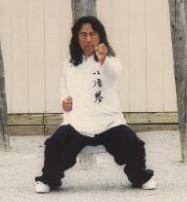Xue Sheng
All weight is underside
Your original question was
And it sounded by your question that you felt this was a fighting stance with this part of your original question that is why I said it was a training stance
Yes he would, if that were a fighting stance, if it were a training stance and you walked in and you ""spring" his leg from inside out with just a little bit force" so he will fall... then you would be rather mean and taking advantage of a person who is not fighting. That is why I said it was a "Training stance"
Now this bit
Let me ask you a question, what trains more muscle, taking a lower wider stance, or a higher narrower stance?
Also on what data did you base your Bell Curve?
Add to that you are using a picture of Jake as a point to argue for or against and frankly that is just a plain silly place to argue from...
If you want to argue against training a horse stance then start form a point that is a realistic horse stance for training in Chinese martial arts such as this one of Tony Yang

Some stances are just too wide. What do you guys think about this one? If you "spring" his leg from inside out with just a little bit force, he will fall.
And it sounded by your question that you felt this was a fighting stance with this part of your original question that is why I said it was a training stance
If you "spring" his leg from inside out with just a little bit force, he will fall.
Yes he would, if that were a fighting stance, if it were a training stance and you walked in and you ""spring" his leg from inside out with just a little bit force" so he will fall... then you would be rather mean and taking advantage of a person who is not fighting. That is why I said it was a "Training stance"
Now this bit
Will it be better to train "leg strength" and "fighting stance (or fighting application)" at the same time so you can kill 2 birds with 1 stone? Of course you can train both separately, but why do you want to do that for?
If you start your horse stance as both feet touching together, you will have poor balance. When you make your horse stance wider, your balance will increase. When your horse stance has reached to the shoulder width, you will have the best balance. If you keep increase your horse stance width, your balance will get poorer and poorer.
It's just like the bell curve. The highest point of that curve is the "shoulder width". The same bell curve also apply to the parallel concept as well. When your feet are pointing inward or outward, you will have poor balance. When your feet are parallel, you will have the best balance.

Why didn't he train the horse stance that he can "use" in fighting such as hip throw, shoulder throw, embrace throw, or ...? In all those throws that require the "horse stance", the width of the horse stance should be as wide as the "shoulder width".
If we care about "train as you fight", your horse stance training should be as just like you will use in fighting when you apply hip throw, shoulder throw, embrace throw, or ... If you use your horse stance in the striking art, you should concern your own balance issue.
Your
- "narrow" horse stance will ask for your opponent's "sweep".
- "wide" horse stance will ask for your opponent's "spring".
Let me ask you a question, what trains more muscle, taking a lower wider stance, or a higher narrower stance?
Also on what data did you base your Bell Curve?
Add to that you are using a picture of Jake as a point to argue for or against and frankly that is just a plain silly place to argue from...
If you want to argue against training a horse stance then start form a point that is a realistic horse stance for training in Chinese martial arts such as this one of Tony Yang




